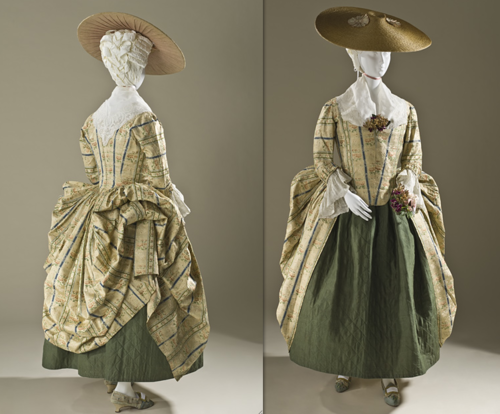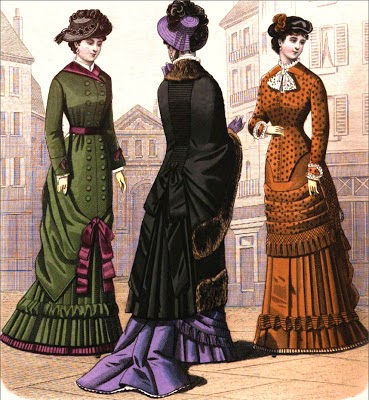Polonaise (clothing)
The polonaise is a woman's garment of the later 1770s and 1780s or a similar revival style of the 1870s inspired by Polish national costume consisting of a gown with a cutaway, draped and swagged overskirt, worn over an underskirt or petticoat. From the late nineteenth century, the term polonaise also described a fitted overdress which extended into long panels over the underskirt, but was not necessarily draped or swagged.
Origin and structure
As early as the 1720s, English painters had begun to portray fashionable ladies dressed in romanticized versions of the costume of a century earlier, as depicted in portraits by Van Dyck and Rubens. By the 1770s, elements of this style began to appear in fashionable dress, including the wide-brimmed hat (dubbed the "Rubens hat" in the Fashionable Magazine of 1786) and bunched-up skirts.
About the same time, French fashion adopted a number of styles of English origin, such as the close-bodied gown which they called robe à l'anglaise, and the fullness of the skirts at the back waist and over the hips. One way to "create the fashionable bulk at the back and sides of the dress was to kilt up the overskirt by means of interior or exterior loops, buttons or tassels to form swags of material. This style ... was known as à la polonaise." This style was characterized by ankle length petticoats that revealed high-heeled walking shoes. Due to this it served as a practical garment for walking because the skirts did not drag along the ground.
Since the beginning of the eighteenth century, middle-class women had adopted various impromptu ways of kilting their overskirts up out of the muck of the streets. The polonaise was a fashionable variant of this style. The name Polonaise (or polonese) derives "obviously from Polish styles—whether it referred originally to the fur trimming or to the kilting up to one side (a Polish fashion which came from Turkish costume) is not really clear.There is some controversy over application of the name polonaise to eighteenth century dress. Some sources define it as being cut in the same fashion as a robe à l'anglaise, but with cords pulling up the skirts in two places in the back, and they date the style from the beginning of the 1770s
"Aileen Ribeiro describes the polonaise as "cut in four parts, two at the front and two at the back,"[5] with the bodice closed at the top center front and sloping away at the sides, leaving a triangular gap that was filled by a false waistcoat. Sleeves could be three-quarter length or long, and various styles such as the Irish, Italian and French polonaise were described by contemporaries. A variation on the robe à la polonaise was the robe à la circassienne, cut the same but trimmed with "oriental" tassels or fur


.png)
.jpg)
EmoticonEmoticon